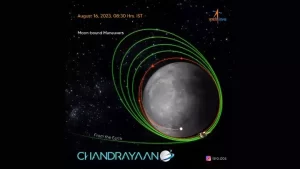Another maneuver by the Indian Space Research Organisation (ISRO) pushed the Chandrayaan-3 spacecraft nearer to the Moon. The lander carrying the rover will separate from the propulsion module and proceed toward the Moon during the next separation phase.
After the August 16 firing, the spacecraft is now in an orbit measuring 153 km by 163 km.Chandrayaan-3 has been successfully launched into the intended orbit of 153 km by 163 km, according to a statement from ISRO published on X. The lunar-bound maneuvers are finished with this. As the Propulsion Module and the Lander Module get ready for their individual trips, it’s time for preparations, the Indian space agency noted.

Moon landing location
August 17 is the scheduled day for the separation of the Lander Module from the Propulsion Module. Vikram, the lander, and Pragyan, the rover, make up the Lander Module. Vikram will descend, and de-boost maneuvers will position it to settle on the Moon’s surface.
On August 23, the Chandrayaan-3 lander is anticipated to touch down on the Moon close to its south pole. The area was chosen by ISRO because it is permanently shaded and has craters that may contain water ice and priceless minerals.
ISRO ensures a gentle launch
S Somnath, the chairman of ISRO, assured the media last week that the Vikram lander can land on the moon’s surface safely even if its engines and sensors malfunction. “If everything fails, all sensors stop working, and nothing works, still Vikram will make a soft-landing provided that the propulsion system works well,” he emphasized.
The main issue facing the crew, according to him, is getting Vikram to land vertically on the lunar surface. “The lander will move horizontally once it separates from the orbiter. To guarantee a secure landing on the moon, the Vikram would be maneuvered into a vertical position, the ISRO director stated.
Read more on: https://dollarsbag.com/microsofts-xbox-enforcement-strike-system-elevating-player-conduct/

